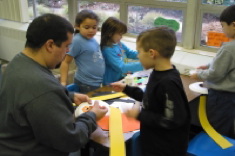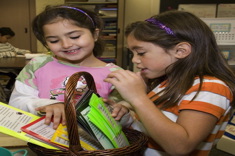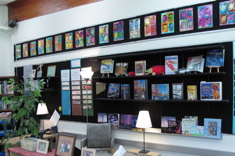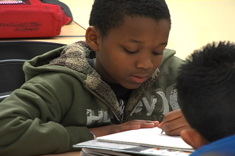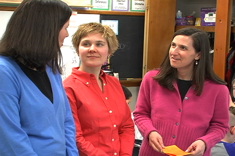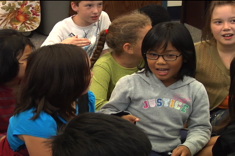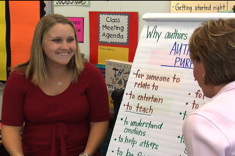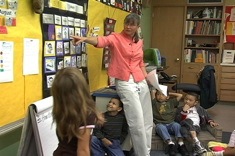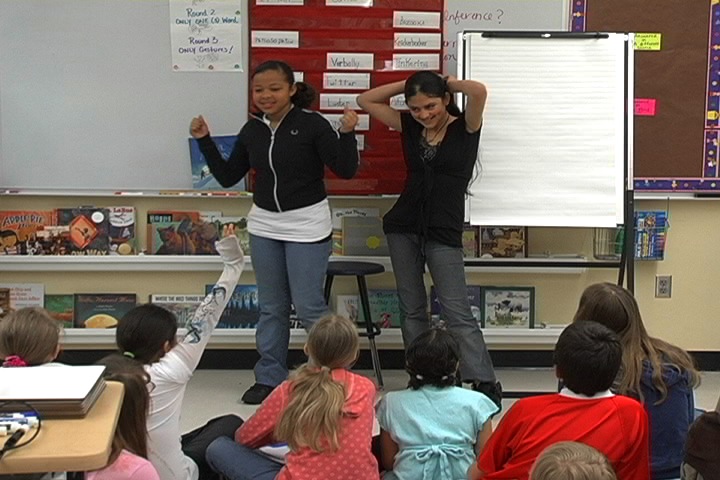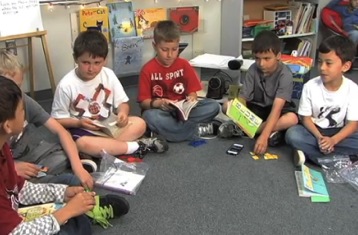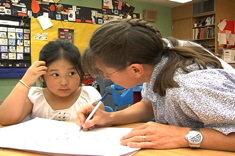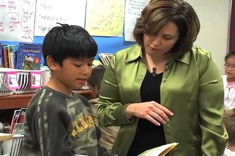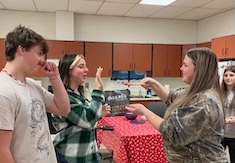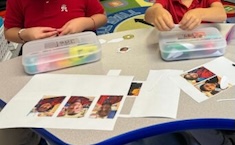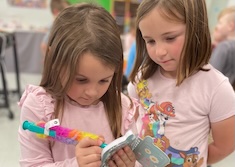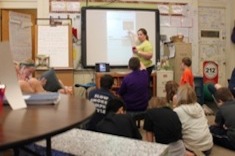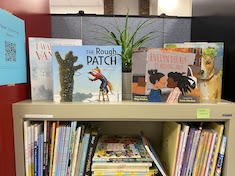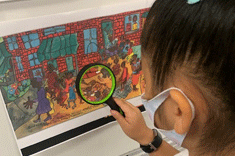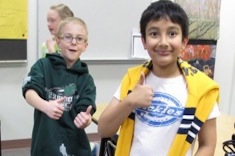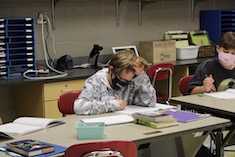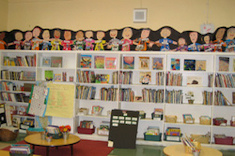Community Building
It's one of the big paradoxes of literacy instruction - students best learn how to read and write independently when they have a strong community of support in classrooms. How teachers build those thoughtful, kind, and challenging classroom communities is explained in these resources.
Latest Content
Family Dichos: Bringing the Language of Home into the Classroom
Ruth Shagoury and Andie Cunningham use dichos (sayings or proverbs) in many languages and cultures to build bridges between school and home.
Creative Literacy Events for Families
Brenda Power suggests formats for events that build stronger home-school connections.
Inviting Students to Organize Books and Materials
Debbie Miller advocates for involving children in the organization of materials for readers and writers in the classroom.
Room for Beliefs: Linking Classroom Design and What We Value
Debbie Miller questions what our classrooms say about our beliefs and practices, and suggests how to bring our designs into closer alignment with our values.
Letters from Home: Letting Families and Friends Teach Us
Brenda Power and Ruth Shagoury use letters from home to learn about students and build community.
On Kidney Tables: Small Changes for Big Effects
When our environment aligns with our values, Karen Szymusiak considers what helps learners take charge of their experience in a successful learning community.
Honor Books: Helping Children and Families Build Bridges Between Home and School
What does Andie Cunningham gets when she mixes pictures from the classroom, messages from families and poetry from teachers? A wonderful recipe for an Honor Book you’ll want to try with your own students.
What’s Valued? Exploring Different Values in Evaluation (E-GUIDE)
Brenda Power shares a workshop series designed to help educators bring their values into closer alignment for a more cohesive experience for students.
We Are All Shamu: What Literacy Leaders Can Learn from Exotic Animal Trainers
If you've ever compared your classroom to a zoo, this article by Brenda Power is for you. You'll take animal trainer advice like "We change behavior in others by breaking routines in delightful ways" and follow it into the classroom.
The Other Buddy: How Partnership Programs Help Older Readers
In many buddy reading programs we often tout the benefits for the younger, less experienced reader, but Shari Frost tells the story of a “big kid” reader with a legitimate reason to read books that were closer to his independent level. Read on.
Opinion Exchange: A Workshop Activity for Study Groups
New teachers need so much their first year and having the ability to be heard and have their opinions valued is right up there. Ruth Shagoury offers a respectful exchange to meet that need.
Helping Young Readers Understand the Middle East: A Booklist of the Best Fiction Picture Books
Do your books reflect the images of your learners' families and culture? Ruth Shagoury offers a booklist to explore the Arab and Persian world.
Every Language Counts: Adding Multilingual Counting Activities to Morning Meeting
Every year kindergarten teacher Andie Cunningham has children who come from homes with many different first languages. She helps welcome these different languages and cultures into the classroom community by counting in different languages during the morning meeting.
Let’s Get Some Attitude
Shirl McPhillips recalls a junior high experience that promoted serious "attitude" and an uproar among her peers.
Boys’ Book Club in Second Grade
In this video from Linda Karamatic’s second-grade classroom, boys discuss the book Fudge using the protocol provided by Linda.
The Difference Between Conferring and “Touching Base”
Debbie Miller goes against the grain, advocating for “the luscious feeling of endless time” as we slow down to confer with children.
Whole Class Interviews: Building Community in Writing Workshop (TEMPLATE)
Interviews early in the year are a potent tool for building a class community.
Connection Points: The Sambusa Was the Key
Becca Burk recalls a pivotal moment when a multilingual student brought her sambusas to taste. Let’s remember that connection points—accepting a gift from home, sitting in the struggle, celebrating the small things, and noticing perseverance—are effective because they allow the child to feel seen, included, and celebrated.
Building Community Around Food and Poetry
Gretchen Schroeder creates strong connections with her high school students as they come together as writers around the shared need for and love of food.
Using Me Boxes to Promote Identity, Academics, and Play
Tara Barnett and Kate Mills share a powerful (and simple) community activity. Students create their own Me Boxes to use (and update) throughout the school year to promote identity, academics, and play. Me Boxes originated from thinking about developmentally appropriate ways to build in work around identity in the classroom, as taught to us by Gholdy Muhammad in her book Cultivating Genius.
Play Is Powerful: Sharing Student Learning with Families
When kindergarten teacher Becca Burk overheard students’ parents comparing herself and a colleague, she reflected on the importance of play for young learners. In this article, Becca shares ways to communicate the power of play and students’ learning with families.
Book Matchmaker: Read Alouds That Invite Young Readers to Participate
Franki Sibberson shares her latest suggestions for read alouds that invite participation from young readers.
Using 9/11 Research to Build Community and Writing Process
Katherine Sokolowski gives space for students to research and share their learning about 9/11 in order to build a community of writers, as well as nourish the research and writing process.
Building Community Access to Texts Through a Lending Library
Tara Barnett and Kate Mills share the way a lending library can provide an additional resource for teachers and community members to quickly get the books they need. They offer practical steps to make the lending library a go-to resource as well as a template to track the monthly book highlights.
Trusting the Letting-Go Moments
Mandy Robek writes a powerful essay about giving her students more decision-making power in sharing their learning. In the release of letting go, she found ease in the joy of learning.
Lifting the Quality of Peer Response
Tony Keefer discovers that his fourth-grade students need focused instruction and support to strengthen their peer conferring skills. Tony shares tips and two video examples from his classroom.
Connecting with Students at Home
Julie Johnson learns some important lessons about connecting with students remotely, and few of them are about technology.
Overcoming: Helping Students Process Covid Feelings
Julie Cox reminds us that for many students, the loneliness and fear of COVID years clings like smoke, and they don’t always have the language to talk about it. While we have worked hard at helping students reclaim content knowledge, we must also help them express and process feelings they might not know how to recognize.
Word Study Literacy Team Meeting
An elementary literacy team discusses word learning in the context of student assessment results as part of a yearlong inquiry into word study.
Classroom Tours: Learning from Colleagues
Barbara Coleman finds classroom tours are a terrific professional development activity early in the year, fostering unexpected collaboration among colleagues.
Browse Content By
Type
Category
- Assessment Tools
- Big Fresh Archives
- Booklists
- Choice Numeracy
- Classroom Design
- Common Core
- Community Building
- Conferring
- Content Literacy
- Digital Literacy
- English Language Learners
- Equity
- Family Relations
- Free Samples
- Guiding Groups
- Leadership
- Literacy Coaches
- Mentor Texts
- Minilessons
- New Teacher Mentors
- Podcasts
- Poetry
- Quote Collections
- Reading Strategies
- Self Care
- Struggling and Striving Learners
- Talking and Listening
- Teacher Study Groups
- Teaching Reading
- Teaching Writing
- Word Study and Vocabulary
Author
- Melissa Quimby
- Nawal Qarooni
- Gwen Blumberg
- Julie Cox
- The Lead Learners
- Hannah Tills
- Josie Stewart
- Ruth Metcalfe
- Mallory Messenger
- Becca Burk
- Jodie Bailey
- Vivian Chen
- Mary Brower
- Tiffany Abbott Fuller
- Stephanie Affinito
- Ruth Ayres
- Leigh Anne Eck
- Heather Fisher
- Shari Frost
- Julie Johnson
- Suzy Kaback
- Gigi McAllister
- Shirl McPhillips
- Melanie Meehan
- Cathy Mere
- Debbie Miller
- Tara Barnett and Kate Mills
- Tammy Mulligan
- Dana Murphy
- Bitsy Parks
- David Pittman
- Brenda Power
- Heather Rader
- Matt Renwick
- Mandy Robek
- Christy Rush-Levine
- Gretchen Schroeder
- Jen Schwanke
- Brian Sepe
- Katherine Sokolowski
- Stella Villalba
- Jennifer Vincent
Grade Level
Choice Literacy Membership
Articles
Get full access to all Choice Literacy article content
Videos
Get full access to all Choice Literacy video content
Courses
Access Choice Literacy course curriculum and training


